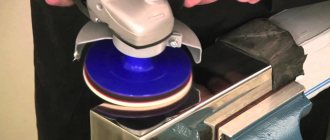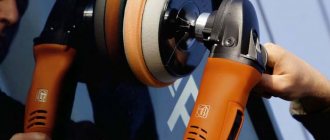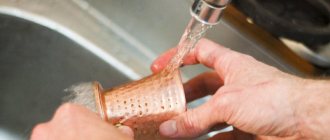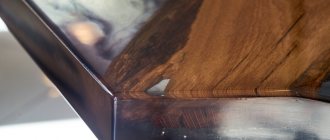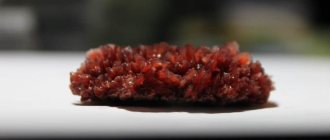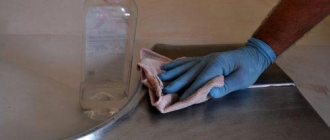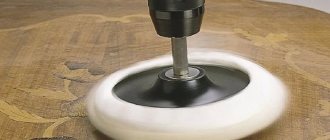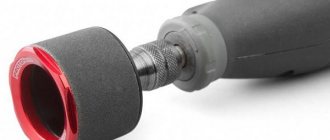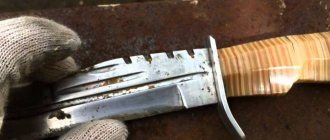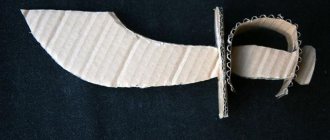When manufacturing or repairing metal products, there is often a need to create a beautiful front surface . To achieve a decorative aesthetic effect, a finishing treatment called polishing .
Polishing technology has been known since Neolithic times, 8000 BC. Products made of bone, stone and native metals (copper, gold and silver) were polished. Among the famous finds of the Neolithic era are polished slabs of obsidian and basalt, which served as a mirror.
Polishing is the final stage of metalworking. During polishing, the thinnest top layer is removed, which allows you to remove roughness, abrasions and small scratches. The polished metal surface acquires a beautiful mirror shine.
In this review you can find out how to polish metal products and what is needed for this.
Definition of the concept of “polishing” and its types
Polishing metal using an angle grinder
Polishing is a type of metal processing, during which the shine is restored to the metal surface. At the present stage, the following grinding methods are distinguished:
- Manual polishing - is carried out mainly during repair work;
- Semi-mechanical polishing - using special polishing wheels worn
Felt polishing discs for polishing metal
on a polishing machine; - Machine method - used in large enterprises. The metal surface is processed by a polishing machine;
- Water jet grinding on special machines. This technology is used only for processing large volumes of products. Plasma and chemical-mechanical polishing work on the same principle.
What tools and machines are used? Mechanical methods involve the use of the following tools and devices:
- polishing machine;
- Grinder;
- electric sharpener;
- drills with clamps.
This finishing method has several advantages. Firstly, it allows you to change the rotation frequency of circles and belts, which has a positive effect on the quality of processing of the metal plane; secondly, additional attachments made of fabric, leather, wool, etc. can be installed on the polishing machine.
Special grinding machine - angle grinder
Manual grinding differs from automated grinding in that its effectiveness depends on the quality of consumable polishing materials. In manual finishing, diamond paste and additives based on chromium or iron oxide are used. Smooth metal surfaces are polished with an ordinary file - a wooden block covered with a cloth, onto which polishing paste is applied.
Polishing metal with a special device
General idea of the design
A denture is a durable and aesthetic orthopedic device that completely replaces lost elements of the dentition.
With the help of such structures, it is possible to restore the physiological and anatomical properties of the dental system. If they are made correctly, they are difficult to distinguish from natural teeth in appearance.
In modern dentistry, there are two main types of dentures - removable and fixed. Various materials can be used for production, such as:
- metals;
- acrylic and resin;
- special plastics.
The design of a removable denture consists of the following elements:
- basis (the basis of the device);
- saddle-shaped part (part of the base in the area of lost teeth);
- clasp (device for fastening a structure);
- artificial teeth (located in the base).
Ivoclar tooth manufacturing technology for removable and fixed dentures.
Come here if you are interested in the types of classification of toothless jaws.
At this address https://www.vash-dentist.ru/protezirovanie/semnyie-p/perebazirovki.html all the most important things about the material used for relining removable dentures.
Combined processing methods
Metal polishing can be carried out using combined methods, in the case of an unprepared and rough surface with rough relief. In this case, a long-term electrolyte-plasma finishing is prescribed, which consists of removing a significant layer of metal.
This processing method is used in extreme cases when quick restoration of the shine of a metal product is required. Among the disadvantages of the technology, one should highlight the high energy intensity, especially at the initial stage of processing, when 100% more energy is used than usual.
Electrolytic plasma polishing machine
An electrolytic plasma polishing machine processes the part in two stages. At the first, the surface is degreased, and at the second, the grinding itself occurs, which, in turn, also consists of two cycles: cutting off the rough layer and grinding the metal. Cleaning from grease is mandatory, since a viscous surface leads to oxidation of the metal and deterioration in the quality of its finish.
Reviews
Many patients note the effect of polishing the prosthesis immediately after the procedure.
The surface of the artificial teeth becomes smooth, shiny, and absolutely no discomfort is felt in the mouth.
High-quality polished and ground dentures sometimes look even better than natural teeth!
You can share your opinion about this procedure in the comments to the article.
If you find an error, please select a piece of text and press Ctrl+Enter.
Tags: denture polishing removable dentures
Did you like the article? stay tuned
Previous article
Features of using the Klammt apparatus when correcting malocclusions
Next article
Purpose and universal properties of gypsum for orthopedic dentistry
Classification of metal polishing pastes
You can bring a metal surface to a mirror state with your own hands without the use of machines; just pay attention to special tools, divided into the following groups:
Types of polishing pastes
- Aquatic. The substance does not contain fat and does its job perfectly;
- Organic products contain paraffin and various oils. They are diluted with various oils and fatty acids;
- Diamond paste is a revolutionary solution that allows you to instantly achieve shine on any metal surface.
Let's take a closer look at the last version of grinding. Diamond paste is so effective that it completely replaces a polishing machine. Diamond Substance is available in two types: ASN and ASM brands (expensive).
Metal polishing paste
Diamond paste has the following advantages:
- Accuracy. Synthetic diamonds allow you to polish any metal product to a shine as accurately as possible;
- Wide range of grain sizes. There are more than 12 grit types available on the market today;
- Simple operation allows you to carry out cleaning procedures yourself without the use of special tools;
- Diamond paste requires minimal tools: a rag, water and rubber gloves.
Table of metal polishes
The main disadvantage of the cleaning product in question is its high price. On average, diamond paste on the consumables market costs more than 500 rubles per 35 grams of the substance.
Working principle of diamond paste
Diamond paste acts on a metal product mechanically and chemically, forming dispersed films. The cleaning agent contains active substances that promote adsorbing processes, which facilitates grinding of the material.
Diamond paste can be of different components
Diamond paste is applied to different types of fabrics (felt, microfiber or jeans), paper, rubber, plastic and other types of non-metallic materials. It is worth noting that diamond paste can also be applied to polishing wheels to increase the efficiency of metal surface processing. In this way you can achieve a mirror effect. Circles made of felt, felt or leather are installed on the polishing machine.
Description of the polishing process
To grind a metal surface you will need: laps and several tubes of diamond mixture with different grits. Diamond paste is evenly distributed over the working surface of a rag or other material. Experts have noticed an interesting pattern that makes it possible to improve the quality of metal processing.
Sanding metal parts
It turns out that you need to add castor or olive oil to the polishing substance. The ideal ratio is considered to be a mixture consisting of 40% diamond dust and 60% oil. After dilution, the mixture is immediately applied to the metal surface.
Related abrasive tools and grinding methods
Experts recommend starting to work only with large grains, gradually moving on to abrasives. During processing, make sure that no unnecessary elements get into the mixture - dust, sawdust, hair or pieces of rags. The presence of foreign objects greatly impairs the polishing to a shine. It is also recommended to wash your hands after changing from one grit to another.
What is grinding of metal surfaces
In the process of creating the required part, the material is subjected to various influences, which do not go unnoticed for the product - various defects inevitably form, such as scratches, slag residues and traces of heat treatment. Therefore, in order to ultimately obtain a perfectly smooth and beautiful metal surface, the part undergoes a grinding process.
Flat grinding of metal is not carried out on surfaces that have defects such as deep scratches or scratches - in this case they cannot be removed in this way.
The grinding process itself involves cutting the surface of a product using an abrasive tool, most often a grinding wheel consisting of many abrasive grains. When the wheel rotates, the edges of the cutting grains remove small chips from the surface of the workpiece.
The grinding process itself has some features that must be remembered when carrying out it:
- The cutting speed must be high.
- Grinding occurs with metal shavings of a special type.
- The shape of the cutting grains of the circle should be multidirectional.
- The temperature at the point of contact with the surface is high.
Metal surfaces subjected to grinding are classified according to the degree of difficulty in processing. Thus, the inner and outer regions of the cylinder and flat surfaces are considered simple. Helical or involute - refer to complex surfaces.
Types of Diamond Dust
On the modern market you can find products not only for polishing metal, but also other materials, for example, wood, glass, stone, etc. They can be classified by color, for example:
Huge range of diamond paste
- Yellow packaging indicates that the substance is intended for grinding ceramic materials and glass products. It is worth noting that this dust can also be used for finishing metal;
- Blue packaging. This type of product is used for finishing glass. The grinding agent has a fairly wide selection of abrasive elements - from 60 to 10 levels;
- The red packaging is suitable exclusively for treating metal surfaces.
As for the packaging itself, diamond paste is sold in compact plastic jars with a volume of 35–45 grams. The average cost of a jar depends on the size and quality of abrasive materials. The finer and higher quality the polishing material, the cheaper the paste costs. The average price is 450–600 rubles.
Basic Rules
The dental technician’s office must be equipped with all the necessary dental equipment , tools and materials for high-quality processing of the prosthesis.
Every qualified dental technician must know the following rules:
- basics of technical use of the equipment on which it works;
- sequence of work performed;
- features of marking and the main properties of the materials used in the work;
- hygienic and aesthetic requirements for prosthetic structures of various types;
- basic technical requirements that apply to the quality of processed dentures and structural elements;
- reasons why a product may be unsuitable, methods for identifying, correcting and preventing them;
- general safety rules.
In addition, the specialist must know the composition of polishing mixtures, be able to prepare them, and also use them correctly.
He needs to correctly select the polishing and grinding mode, depending on the material from which the prosthesis is made. It is best to use modern specialized equipment, high-quality tools and materials in your work.
However, the key to a safe and successful procedure is an experienced, qualified specialist who will process the prosthesis in accordance with all established rules.
Paste GOI
GOI chrome paste is a universal product used for polishing metal and non-metallic surfaces. Although it was invented in the early 1930s, it is still used to polish metals today.
Polishing paste GOI
The GOI product comes in different grain sizes (classified according to the size of the abrasive materials). There are different types of grain size: fine, medium, and coarse. Fine dust is used for polishing soft and non-ferrous metals, coarse grains are used for rough finishing of ferrous metals and steel.
Features of use. Initially, the polishing agent has a solid structure, which can be diluted with a few drops of machine oil. If you need to polish an uneven metal surface with bends, it is recommended to apply the paste diluted on a rag.
Polishing with GOI paste
The second polishing method is intended for processing smooth metal surfaces. Its peculiarity is that a small amount of abrasive material is applied to a wooden block. Then it is recommended to make methodical movements back and forth along the surface being treated.
For manual grinding, it is recommended to use soft types of fabrics - cotton or flannel; for ferrous metals, denim or canvas fabric is suitable.
Final finishing
The final stage in the manufacture of a prosthetic product is its polishing, due to which it becomes smooth. It is this surface that guarantees reliability, aesthetics, hygiene and durability.
When polishing, the specialist must hold the product with the index, thumb and middle finger. First, the interdental spaces of the structure must be treated with a cone felt.
Next, the entire prosthetic surface is polished with a cylindrical felt, with the exception of the side that faces the alveoli and palate.
During processing, it is necessary to periodically wet the structure with a solution consisting of water and polishing powder dissolved in it.
also necessary to avoid touching the edges of the denture with brushes . All small metal elements and clasps are polished separately and pre-polished.
At the end of the process, all parts receive shine, thanks to the fact that they were finally treated with a thread brush with “Goya Paste”. But here it is important for the technique to take into account one point - you should not rub the same area for a long time.
Important! To prevent the product from deforming, it should be periodically moved in your hands. And to prevent it from melting, you can’t press the nozzle too hard against it.
At the end, the denture should be rinsed well using a brush, soap and warm water, and then dried. Unlike grinding, polishing speed is higher. Moreover, the harder the material of the prosthesis itself, the faster this manipulation takes place.
